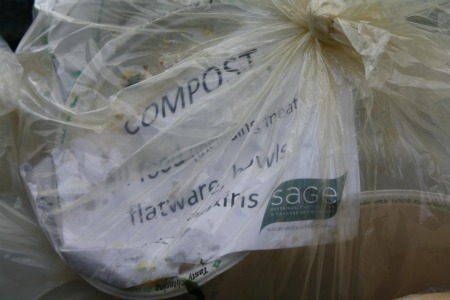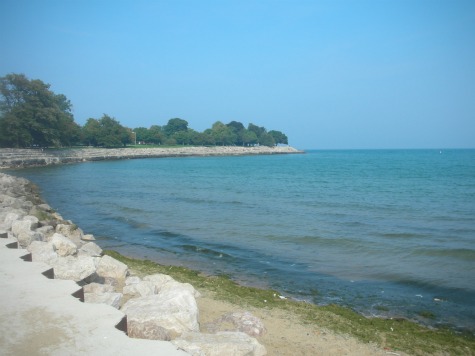August 2011 Archives
Americans throw away 96 billion pounds of food each year. Hold on. Before you read further, consider the sheer amount of food that is. With a population of just over 307 million, that means each American is putting almost 6 pounds of food into landfills every week. One particularly egregious offender in terms of waste is events, where disposable items like plates and flatware abound. The Facilities Services Annual Picnic, one such event, reduced its waste this year by introducing composting.

In previous years, Facilities Services (FS) had “gone green” and recycled cans and plastic at the event. This August, composting was the soup de jour at the event, along with some pulled pork and grilled items, of course. A total of seven bags of compost were collected at the event; meaning seven bags were made into fertilizers for soil instead of rotting and emitting carbon dioxide in a landfill. Plates, flatware, napkins, cups, and surplus food all made their way into compost bins—even the paper signs labeling the bins were composted! Aluminum cans and cardboard were recycled, thus the only items in the garbage were the ice cream wrappers and potato chip bags. Perhaps next year we can eliminate these items, implement large tubs of ice cream, and make the event zero-waste!

Looking back on the picnic, composting was a great success, though it was a bit of a challenging transition to make. Compost must be collected in compostable bags and all containers must have only compostable materials in them. There were six stations, each with one trash bin, one or more recycling bins, and one or more composting bins. Over 300 people attended this event, most of who were unfamiliar with composting, making it difficult to ensure everyone was properly disposing their picnic waste. Members of the Office of Sustainability actively helped Facilities staff to some extent, though future events would benefit from volunteers at each station to help direct people and separate refuse.
Many thanks to Carla Nelis, Administrative Manager of Facilities Services, as well as ORCSA, and the Grounds Crew, for making this composting possible on such short notice.

Ok, I’ll admit it. When I think “August” I don’t immediately hear Frank Sinatra crooning that oh-so-memorable tune “Come Fly With Me.” I do, however, get excited for my vacation to the sunshine state and look around at my empty office, a tiny bit envious of my colleagues who are undoubtedly sunbathing (or melting) in Florida and California. And then I put on Frank. August is undoubtedly a season filled with flying migrations—of people, trying to squeeze in every possible minute of sunshine before the dreaded school year begins. So when you’re packing your sunglasses and flip-flops this month, try these quick tips to lower your carbon footprint:
- Take a direct flight: Not only will this save you time, but it will also buy the environment a bit of time. Planes use the most fuel during takeoff and landing, so the less your trips require these, the better.
- Choose a newer airline: This might result in more decadent (if you’d describe them that way) snacking and more comfortable seats, but more importantly, that aircraft will most likely be newer than the jet that older airline has been using for 20 years. Newer plane = more efficient. It’s that easy—thanks, technology.
- Fly during the day: Surprising? While day and evening flights produce the same amount of carbon emissions, the warming effects of airplane contrails during the day are cut in half thanks to sunlight reflection.
- Bring your own reusable water bottle: This way you won’t end up wasting a bottle and buying a new one after passing the scrutiny of the TSA. Midway airport and others around the country (SFO, for example) have stations after security where you can fill your bottle with tap water
- Think sustainably: Sure, you’re hungry, but before you grab that large to-go plastic container filled with goodies, consider dining there on porcelain plates or going for smaller containers. Bottom line: what goes in the trash goes in a landfill, so when you’re tempted to grab a big plastic bowl of raspberries (and you don’t see recycling around), get a banana instead. No packaging means less plastic in landfills.
Whether you float down to Peru or find yourself in Ipanema, travel safely and allot extra time for all that summer terminal traffic. Happy flying!
*Source: Rogers, Elizabeth. Shift Your Habit: Save Money, Save the Planet. New York: Three Rivers Press, 2010 Photo Source

Nothing says summer quite like lazy days at the beach. But before you grab your folding chairs and beach balls, you might want to check out your coastal destination. In 2010, the number of beach closings and advisories in the U.S. reached 24,091—the second highest in 21 years. Looks like the SPF on that bottle of sunscreen isn’t the only thing you should be worried about when you head to the nearest shoreline.
The vast majority (nearly three out of four) of beach closings and advisories in the U.S. result from high bacterial levels in the water. Poorly designed and aging sewage treatment systems are frequently to blame for this problem and some situational factors can exacerbate them. After a period of heavy rains, for example, sewers often overflow and untreated water makes its way into waterways and beaches. It’s wise to avoid beaches for at least 48 hours after heavy rains when the probability of this problem affecting water quality is highest.
It’s best to use caution when swimming at a beach, especially after heavy rains or if the beach has notoriously contaminated water. It’s also important to note that it takes 24 hours for a water quality test to produce results. Considering that swimming in dirty beach water could lead to skin rashes, pinkeye, respiratory infections, meningitis, and even hepatitis—you might want to err on the caution when it comes to going for a dip on the lakeshore.
One thing to note when you’re enjoying the beaches of Chicago is the color of the flag near the lifeguard stand. Red signals a swimming ban, yellow an advisory, and green means good to go. These flags indicate weather conditions that make swimming dangerous or poor water quality. In Chicago, waters are tested five days a week and the Chicago Park District’s facebook page provides beach closing announcements. In Cook County, the Natural Research Defense Council’s (NRDC) analysis showcases North Avenue beach as having the safest water, with fewer than 3% of samples reaching above normal bacterial levels. Watch out for the beaches of Evanston and the South Shore, where water samples are unsafe one out of three times.
The NRDC has created a chart rating the safety of many beaches around the US based on their water quality history, testing frequency, and advisory history. Click here to see how your local beach measures up. You can also get the daily Beach Report for Chicago here.
